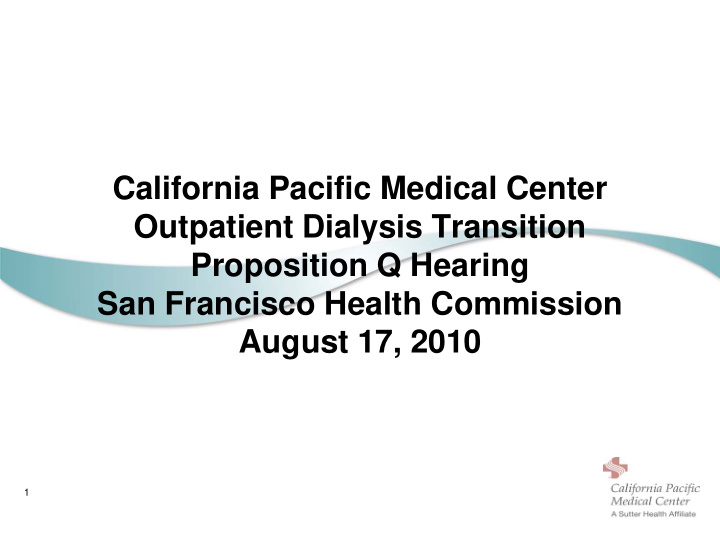



California Pacific Medical Center Outpatient Dialysis Transition Proposition Q Hearing San Francisco Health Commission August 17, 2010 1
Overview Presenter: Grant Davies, FACHE Executive Vice President, CPMC • Situation • Goal • Plan • Trends in Dialysis Centers in the United States • Trends in Dialysis Centers in California and San Francisco • Dialysis Specific Regulatory Changes • Why Davita • Our Process • What Will This Mean to the Patients and the Community Presenter: Michael Borah, MD Medical Director, Dialysis Services, CPMC • Quality of Care in Dialysis • Question and Answer 2
Situation • CPMC operates two dialysis clinics at the Pacific and Davies Campuses • 245 Hemodialysis patients • 30 Peritoneal dialysis patients • Increased regulation • Decreasing reimbursement • Capital reinvestment necessary • Evaluating ability to stay in program all together 3
Goal • Continue to offer outpatient chronic dialysis at our facilities into the future. • To identify a high quality partner to maintain continuity of care and enhance the outpatient chronic dialysis experience for our current dialysis patients. • Maintain employment for our dialysis employees. 4
Plan • The centers will remain in their current locations at Pacific and Davies. • The same physicians will continue to direct the clinical care of the centers. • Every employee will be offered a job with Davita at the same center. • Inpatient and acute dialysis will continue to be provided by CPMC nurses. 5
Trends in Outpatient Dialysis Centers in the United States Year Location 1991 1995 1999 2003 2007 Hospital Based 29% 23% 16% 13% 11% Non Hospital Based 64% 71% 78% 81% 84% Other 7% 6% 6% 6% 5% Total Centers 2159 2887 3842 4584 5228 6
Trends in Dialysis Centers in California and San Francisco • Approximately 5% of California hospitals operate dialysis centers. • CPMC centers are currently largest hospital operated dialysis centers in California. • No other community hospitals in San Francisco operate dialysis centers. 7
Dialysis Specific Regulatory Changes • Changes in CMS Conditions for Coverage in 2008 – First change in dialysis regulations since 1976 – Mandated programmatic changes driving towards continuous care management via interdisciplinary team approach – New documentation requirements – Drastic operational changes necessary for compliance – Need to invest in the replacement of clinical equipment and upgrade facilities 8
Dialysis Specific Regulatory Changes • Bundled Reimbursement from CMS beginning in 2011 – Mandated by Congress in 2008 with passing of Medicare Improvements for Patients and Providers Act (MIPPA) – Current reimbursement from CMS combines separate payments for dialysis treatment, drugs, lab tests, etc. – New reimbursement combines all into single payment at average 2% decrease in reimbursement – Expenses to deliver dialysis continues to grow 3-4% annually 9
Why Davita • 1600 centers nationally – Two in San Francisco – Webster Street Clinic 1499 Webster St – China Town Clinic 636 Clay St • Approximately 120,000 patients nationally or 1 of 3 patients who are on dialysis • Current Hospital Based Partnerships: USC, UCLA, Johns Hopkins, University of Texas, University of Chicago, University of Oklahoma, University of Nebraska, University of Alabama 10
Our Process • Eight Patient Forums – December 2009 to present • Commitment to continue to meet with patients to address concerns • Longtime Medical Director Dr. Michael Borah has been involved from the very beginning of the process • Weekly staff meetings on transition – August 2009 to November 2010 • Due diligence period – August 2009 to July 2010 • Davita Open Forums and Individual Employment Offers to Employees – August 9-20, 2010 • Clinical, Operation and IT Integration of clinics into Davita – September 2010 to January 2011 11
What Will This Mean to the Patients and the Community? • CPMC can continue to offer onsite chronic outpatient dialysis services as we have for many years; at the same locations with the same physicians and most of the same staff members. • Davita will make significant capital investment into new furnishings, clinical equipment and information technology immediately. 12
Quality of Care in Dialysis • CMS has mandated submission of clinical and quality data from all dialysis centers in the US for decades • The Dialysis Facility Compare data is publically available at medicare.gov and facilities must report on standardized Clinical Performance Measures that have been validated to be relevant indicators of the quality of care delivered at OP chronic dialysis centers • These indicators include: – Adequacy – Albumin levels – AV Fistula Use – Mortality 13
Quality of Care in Dialysis % Davita Indicator Davita Nat’l Favorable Kt/V > 1.2 95% 90% 6% Albumin >3.5 g/dL 82% 81% 1% Pts w/ Fistula in Use 59% 50% 18% Survival rate 83% 81% 3% Notes: The national data is inclusive of 33% Davita centers, therefore the national data is skewed favorably than if the Davita data is removed. This is why the % DVA Favorable rate is different than the difference between Davita and National. Source: DaVita.com 2007 CMS Clinical Performance Measures Report (most recently published data; results from 2006 calendar year) Fistula First National Vascular Access Improvement Initiative Website (www.fistulafirst.org), results from June 2008 14 2007 USRDS Annual Data Report (most recently reported data; results from 2005 calendar year, Table J 16)
Question and Answer ? 15
Recommend
More recommend